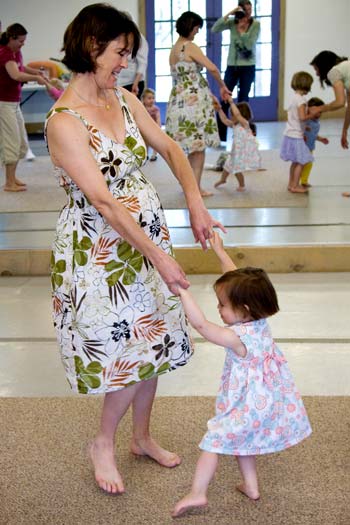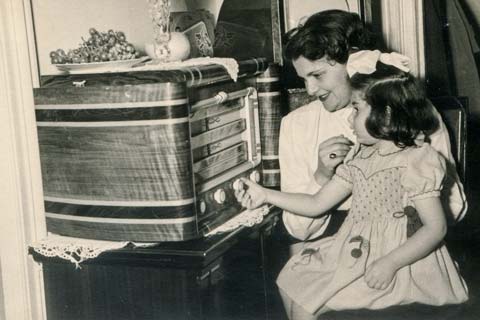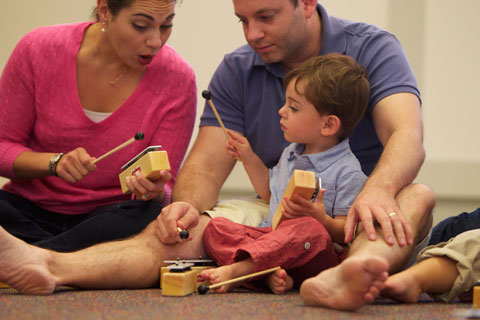High Tech—and Still High Touch
By Devi Borton, M.A., Certified Music Together Teacher Trainer
 Did you make personalized CDs for your friends when you were a teenager but now recommend Spotify playlists instead? Maybe you used to dance along to records but now your family loves to jam to music videos on YouTube. Technology may have changed some of the ways in which we access, share, and interact with music, but our desire to use music to connect with those we love is timeless.
Did you make personalized CDs for your friends when you were a teenager but now recommend Spotify playlists instead? Maybe you used to dance along to records but now your family loves to jam to music videos on YouTube. Technology may have changed some of the ways in which we access, share, and interact with music, but our desire to use music to connect with those we love is timeless.
Helping you to make music an important part of your relationship with your child has been a key element of Music Together since it began three decades ago. To inspire singing and dancing throughout the week, we’ve gone from giving out tapes and handouts to CDs and songbooks—now supplemented by digital downloads and online resources. Keeping up with the times allows Music Together to remain accessible to all while helping families and classrooms reclaim the powerful and joyful practice of singing and dancing together.
Music used to be an organic part of everyday life, woven into our work, play, and cultural rituals. In fact, until the end of the nineteenth century, if we wanted to hear music, we had to make it ourselves! There was no iPod, radio, phonograph, or CD to do the work for us. Singing and dancing together were the default entertainment options well into the twentieth century; and as recently as forty-five years ago, pianos were a standard piece of furniture in middle-class homes and kindergarten classrooms. (Morgan 2011) With daily opportunities to interact musically with others, plus strong social support, developing skill in music came as naturally as learning to talk. Sadly, this is no longer true.
It's tempting to create a dichotomy about then and now. But technological inroads into our musical lives are not new. The mid-1800s saw the mass-production of the player piano, making music easier to access and experience. Then, the radio and gramophone brought an explosion of new listening opportunities. While these innovations seemed to support families and schoolchildren in singing along and learning to play instruments, these early forms of recorded music actually began to discourage people from singing or playing music themselves. After all, the professionals could now do it for them—and “better.”

Fast-forward to 2015, and we can appreciate this unintended consequence even more. Many parents and teachers still sing their children to sleep and use playful songs to make transitions smoother and daily activities more fun. But many others do not, thinking that professional recordings sound better than their own imperfect voices. That may be true, of course, but look at the message this conveys to children about singing: that it’s reserved for the people who do it really, really well.
Today’s family road trips more often involve plugging into devices than plugging into each other through singing; and our personal repertoire has dwindled. The average family in North America now knows only three to five shareable songs! (Trehub 1999) Skill development is also at increasing risk: research indicates that fewer than 50% of kindergarten-age children know the difference between their singing voice and their talking voice. (Levinowitz et al. 1988)
While DIY music-makers might seem to be an “endangered species,” we now have access to music content as never before. Songs are accessible in multiple ways, and thousands of them can fit inside a device that weighs less than a pound! The latest technology is more interactive than ever, offering us many ways to connect musically with others. Apps provide the words to songs we want to sing around the campfire. Families share silly songs in video chats with distant parents or grandparents. Moms and dads use social media to share videos of their children drumming or dancing. Creations like Eric Whitacre’s “Virtual Choir” enable tens of thousands around the globe to upload their voices and join the largest collective choir in history. It seems that our human need for connection through music may not have been replaced by high tech after all. In fact, trends suggest that people are now using technology to bring them closer to friends and family. (Nielsen 2014)

Research about the role of technology in early learning is burgeoning, as society works to understand both its value and its risk. Here at Music Together, we are paying very close attention to technology’s impact on music-learning. We know that an interactive, dynamic feedback loop (or “serve and return” exchange) between child and adult is crucial to the strengthening of brain architecture in the young child. The acquisition of any skill, including the ability to sing in tune and move with accurate rhythm, relies on the participation, modeling, and support from a child’s important adults.
So, the question before today’s caregivers has become: how do we accept and include technology in a way that supports how young children learn best?
Zero to Three editor Stephanie Powers asserts that the question about children and technology has changed from “is media and technology good or bad for children?” to “how can we use media and technology responsibly and in helpful ways?” (Powers 2013) Across the board, the answer seems to be: make conscious choices to leverage technology rather than using it as a substitute teacher. According to Claire McCarthy, a Boston pediatrician, “There's an awful lot we don't know about the effects of screen time on babies and toddlers…But here’s what we do know: when screens displace interactions with people, they are bad for babies and toddlers.” (McCarthy 2015)
Research that focused on how infants begin to receive and process language concluded that videos do not teach very young children. On the contrary, it is emotional, multi-sensory, and nuanced cues unique to human interaction that are critical to infant language acquisition. (Kuhl 2003) Music development, too, is enhanced by adult responsiveness. Music Together CEO Susan Darrow says, “When an adult and child have an interactive music experience, the child’s learning and development is naturally supported when the grownup plays off the child’s musical expression, accepting and including all offerings.”

At Music Together, we’re intrigued by the possibilities introduced by technology, especially ways in which it can assist participation and learning in music. But we are also clearer than ever that if technology is used with young children, it should always foster live, interpersonal interaction and build bonding and human relationships.
We invite you to join us in taking a deeper look, both now and into the future, at the evolving role technology is playing in your family’s life. As you do, we hope you continually discover ways in which high tech can bring more high touch into your daily life.
References
Bronson, Po and Ashley Merryman. Nurture Shock. New York: Hatchette Book Group, 2009.
Cowman, Krista. “From Parlour Songs to iPlayers: Experiencing Culture in the 20th & 21st Century Home.” Cultural Value, Arts and Humanities Research Council Workshop Report (May 2014).
Dobney, Jayson Kerr. “Nineteenth Century Classical Music.”
“In Search of Lost Time.” The Economist, December 20, 2014.
Levitin, Daniel. “Do You Hear What I Hear?” The Wall Street Journal, December 13, 2008.
Levinowitz, Lili M., P. Barnes, S. Guerrini, M. Clement, P. D'April, and M.J. Morey. "Measuring Singing Voice Development in the Elementary General Music Classroom." Journal of Research in Music Education, 46:1 (1988): 35-48.
Klein, Lauren. http://www.greatergood.berkeley.edu
Macvean, Mary. “The Piano's Status in U.S. Living Rooms Is Declining,” L.A. Times, May 16, 2009.
“Millennials: Technology=Social Connection.” Nielsen, February 26, 2014.
Morgan, Harry. Early Childhood Education: History, Theory and Practice. Maryland: Rowman & Littlefield, 2011.
McCarthy, Claire, MD. “The One Thing We Know For Sure about Screens and Babies.”
Powers, Stefanie. “This Issue and Why It Matters.” Zero To Three Vol. 33 No. 4 (March 2013).
“The Virtual Choir,” http://ericwhitacre.com/the-virtual-choir
Trehub, Sandra and Lili M. Levinowitz. Lecture, Early Childhood Music and Movement Association Conference, Boston, MA, 1999.



